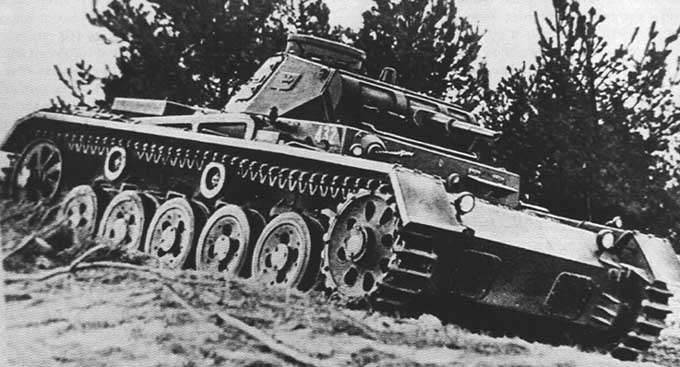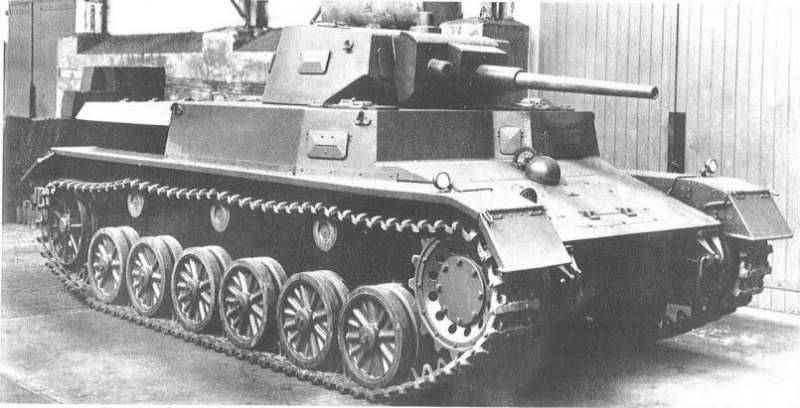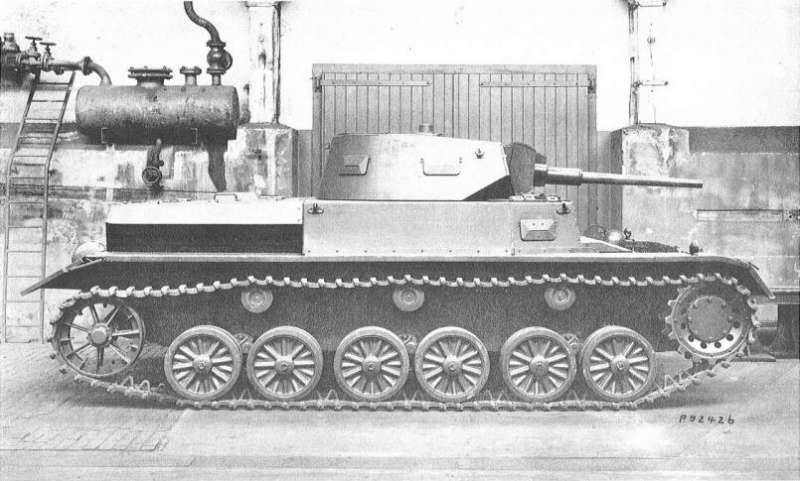Medium tank project for export deliveries MKA (Germany)
History MKA project (Mittlerer Kamfpanzer Ausland - "Medium tank - foreign countries") goes back to the program of developing a promising medium tank for the Wehrmacht. At the beginning of 1934, a project was launched to create a new armored vehicle, in which Daimler-Benz, Krupp, MAN and Rheinmetall firms were involved. The result of subsequent work was the emergence of several new projects of tanks. The car, created by Daimler-Benz specialists, was put into service in 1936 under the designation Panzerkampfwagen III Ausf.A. Other projects, including the development of Krupp, in turn, were out of work.
Not wanting to lose possible orders, Krupp continued the development of its version of the medium tank. At the beginning of 1936, a proposal appeared to develop, on the basis of existing armored vehicles, new models, originally intended for delivery to foreign countries. The idea of creating a special export light tank has already received the approval of the leaders of industry and military command. Thanks to this, it was possible to offer a medium tank project.
According to reports, initially the Krupp company planned to offer potential customers an already existing medium tank that could not beat the competition in the competition of the German army. However, such plans did not receive the approval of the command. The military considered that this project uses too many new components that cannot be transferred to third countries. It was forbidden to export armor made according to new technologies, sighting devices and other optics. As a result, the specialists of the company-developer had to change the project and remove the required components and assemblies from it.
Also, the army demanded to ensure a gap in characteristics between the tanks for the army and for export supplies. Their cars Pz.Kpfw.III and other equipment should have a noticeable advantage over tanks for third countries. As a result, Krupp had to make significant changes to the project several times associated with certain design features. In addition, this led to a significant delay in the work. The final version of the new project was approved only in 1939 year.
In addition to improvements related to the need for secrecy, the new project was proposed to take into account the peculiarities of potential competitors. It was assumed that in the international arms market the new German tank would compete with British Vickers vehicles, the French Renault R35 tank and some other types of equipment actively bought by different countries. As a result, the main characteristics of the German export tank should not be inferior to the existing market leaders and even surpass them.
The project of the tank for export deliveries received the symbol MKA (Mittlerer Kamfpanzer Ausland). This name was chosen by analogy with the LKA (Leichter Kamfpanzer fur Ausland) project already under development, the goal of which was to create a light tank for sale abroad.
In connection with the requirements of the military, the authors of the project had to significantly rework the design of the armored hull of a promising tank. One of the main tasks in creating the corps was a reasonable reduction in the level of protection necessary to preserve the advantages of the newest German tanks. At the same time, however, the finished hull of the MKA tank turned out to be very similar to the units of the new Pz.Kpfw.III. In particular, the layout traditional for the German tanks of that time was preserved: a transmission was located in front of the hull, a command and control compartment was behind it, and the engine contained the engine with the necessary equipment.
The body was proposed to be assembled from rolled sheets of different thickness. The forehead was defended with 25-mm sheets, the sides were 18 mm thick, and the sides of the turret were made of 16-mm parts. As part of the case, only flat sheets of different shapes and sizes were used, no curved parts were envisaged. Connecting parts of the body was proposed by welding. An interesting feature of the case related to the requirements for the level of protection was the use of an inclined frontal sheet. The remaining parts, however, were arranged horizontally or vertically, or with a slight slope.

Serial tank Pz.Kpfw.III Ausf.A
The frontal part of the body was formed by two inclined sheets of different sizes. The top was installed with a large slope in comparison with the bottom. In the back of the upper frontal sheet, on the left side, a small protruding cabin of the driver was fastened. Its details, as well as other elements of the upper part of the forehead, should be installed with a minimum deviation from the vertical. The driver’s cabin and the frontal sheet mounted next to it formed the front part of a large box with turrets. She had small cheekbone details and slightly inclined inside the side. The stern of the hull had a narrowed upper part, on which the necessary aggregates were mounted.
It was proposed to mount a rotating turret with armament on the underboard box. The shape of the tower was determined based on the experience of creating such products. A comparatively small frontal leaf was installed with a slope inward. On the sides it was necessary to fasten the sides and the stern, made in the form of a single component of a curved shape. Above, the crew and weapons were protected by an armored roof.
Initially, the MKA project implied the use of a Maybach HL 76 carburetor engine with 190 hp power. As the project progressed, it was decided to use a more powerful power plant. The result of such changes was the fact that an experienced car received a Maybach HL 98 motor with an 230 hp power. Replacing the engine should have a positive impact on the characteristics of the tank. The engine was located in the aft compartment of the hull, where fuel tanks, radiators, etc. were located next to it. Directly with the engine, the drive shaft connected under the floor of the fighting compartment was connected. His task was to transfer torque to the mechanical transmission, located in front of the hull.
The chassis of the export tank was developed on the basis of existing technical solutions. On each board it was proposed to mount six track rollers, interlocked in pairs. Each trolley with two rollers was equipped with its own shock absorber. Above the axles of attachment of the trolley were placed supporting rollers. A large drive wheel was located in the front of the hull, and the guide, which had a spoke-based structure, was proposed to be installed in the stern.
In the turret of the tank was to be installed machine-gun armament. According to various sources, for use on the MKA car, two versions of the gun were considered. These were a 45-mm semi-automatic gun with a barrel length 50 caliber and 50-mm gun with a barrel of the same length. Some sources mention that the 45 mm caliber cannon was developed by German industry based on a study of captured BT tanks of Soviet construction captured in Spain. Apparently, such weapons interested the German specialists, the result of which was the emergence of a similar system of its own design.
In one installation with a gun, a rifle caliber machine gun was to be mounted. The general mechanisms and one telescopic sight at the gunner’s workplace were used to target the gun and the machine gun. In connection with the required reduction in combat characteristics, the armament of the export tank should consist only of a cannon and a machine gun. Machine gun in the front hull sheet, smoke grenade launchers, etc. not envisaged.
The crew of the MKA tank was to consist of four (according to other sources, five) people. These were the driver (and his assistant), the commander, gunner and loader. For the driver and his assistant provided space in the front of the case. The remaining crew members were to be located in the fighting compartment, in the tower. The control compartment provided for two hatches in the roof for access to the inside of the hull, as well as several inspection hatches. The driver had three viewing devices in the details of his cabin, and his assistant could observe the situation only through the flap in the cheekbone of the hull. At the disposal of the commander, gunner and loader there were hatches in the roof of the hull, as well as several viewing instruments in the sides of the tower. For servicing various components and assemblies, hatches for the engine (in the rear of the hull) and transmission (in the front plate) compartments were provided.
At the request of the military, a third-country tank should not have been equipped with a radio station to communicate with other vehicles. In addition, for this reason, a radio operator was removed from the crew. Instead, in front of the hull, on the starboard side, an assistant driver was to be placed. The machine gun installation at the right place of the department of management was not applied.
The medium tank developed by Krupp was supposed to have a combat mass at 12,1 t with a total length of 5,1 m and a width of no more than 2,4 m. A relatively powerful 230-strong engine had to accelerate the car to 40-42 km / h on the highway. Other indicators of mobility should have been at the level of other machines of German design.
The creation of the MKA project, due to various difficulties, was completed only in 1939. Completion of the design work allowed Krupp to proceed with the assembly of a prototype, which was to confirm the design characteristics. It was at this stage that another change occurred in the project, which led to the use of the Maybach HL 98 engine with an 230 horsepower XP. The use of a more powerful engine could lead to a significant increase in mobility in comparison with the design parameters.
In 1940, the first prototype of the new tank was put to the test. During inspections in field conditions, the car showed its best. It was found that the tank was not just good, but too good for deliveries to third countries. In terms of mobility, the machine was not inferior to equipment for the German army, and also had some advantages in defense and firepower. For example, the frontal projection of the MKA was slightly better protected than that of the Pz.Kpfw.III, and the 45 or 50-mm gun was much more powerful than the 37-mm gun. The lack of communications, in turn, could not compensate for this gap and ensure the export tank’s lag behind other vehicles for its own troops.
In the second half of the 1940, the new MKA tank was ready for sale to foreign countries. However, by this time, Germany was already at war in Europe, which made it difficult to find potential buyers. In addition, there were risks associated with the workload of the industry with their own orders. Attempts to sell new equipment to the Allied countries were unsuccessful. Italy, Spain, Japan and other friendly countries showed no interest in the new German-made medium tank. The ability to offer development to other states from a certain time was simply not available.
After failures in the international market, Krupp attempted to propose the MKA tank of the German army. However, this machine initially did not meet the requirements for equipment for the Wehrmacht, because of which it could not be the subject of a contract. An attempt to sell the export tank of his army naturally ended in failure.
Having passed the tests and not interested potential buyers, the only copy of the MKA medium tank remained out of work. The car already had no prospects, and its very existence was considered meaningless. At the end of 1940, the only prototype export tank was dismantled for metal. Construction of other cars of this model did not begin and was not planned.
In the second half of the thirties, Krupp made two attempts to develop armored vehicles specifically for sale to foreign customers. The result of the first such project was the light tanks LKA and LKB, and the second led to the construction of the MKA machine. Despite all the positive qualities, such equipment could not interest the customers. The construction of export tanks was limited to only a few prototypes, after which all such work ceased, and the Krupp company focused its efforts on working in the interests of the German army. No more attempts were made to create a special export tank.
Based on:
http://achtungpanzer.ru/
http://aviarmor.net/
http://lexikon-der-wehrmacht.de/
http://wot-cone.blogspot.ru/
http://strangernn.livejournal.com/
Chamberlain P., Doyle H. Complete reference book of German tanks and self-propelled guns of the Second World War. - M .: AST: Astrel, 2008.


Information